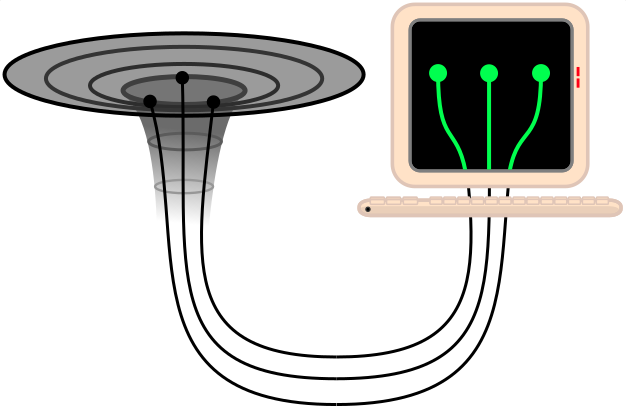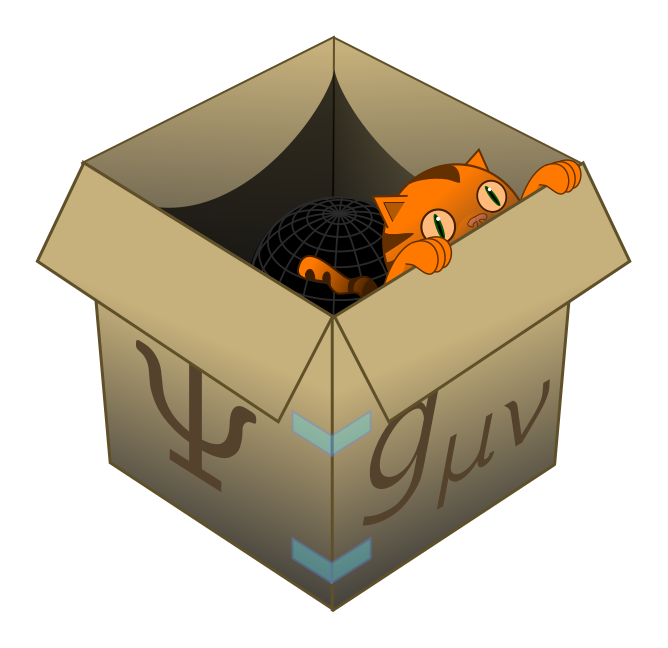- Quizzics (2019). Multiple choice questions contributed to the UBC high school Physics Olympics. My problems featured in a local newspaper article on the event!
I study string theory and quantum gravity, with a particular focus on the AdS/CFT correspondence. This is the crazy-sounding proposition that quantum gravity in (d+1)-dimensional, saddle-shaped space is exactly equivalent to a regular quantum theory in d dimensions. For instance, a 3D black hole can be simulated on a 2D quantum computer!

Coming soon: a 5 levels style explanation of my research.
Technical overview
- Black hole microstate cosmology (2018). Sean Cooper, Moshe Rozali, Brian Swingle, Mark Van Raamsdonk, Christopher Waddell, David Wakeham. arXiv: 1810.10601.
- Peeking behind black hole horizons with boundary states (2018). A talk on boundary state black holes given at the University of Melbourne.
Nontechnical overview
I study quantum gravity. Loosely speaking, this is the theory needed to describe what happens when you throw Schrödinger’s cat into a black hole. Although quantum gravity is poorly understood in general, in one setting we have made impressive progress: quantum gravity in a box.

So, suppose I give you a box with a little universe inside. This little universe is governed by gravity, a geometric theory where objects can stretch, curve and collapse into black holes. 20 years ago, physicists discovered a miracle: quantum gravity inside the box is encoded in ordinary quantum physics on the surface. This is a bit like a hologram, where we can “see” a three-dimensional image emerging from a two-dimensional surface, so the relationship between inside and outside is called the holographic correspondence.

Let’s return to the unethical experiment proposed above, where we drop Schrödinger’s cat into a black hole. Do we understand what happens in the simplest quantum gravity setting, when the black hole is inside the box? Well, not exactly, but a remarkable simplification occurs: using the holographic correspondence, the black hole can be understood as a special type of quantum computer, and dropping the cat becomes an information processing task. So we can study quantum gravity by learning more about quantum computers!
For information about old research projects, see this page.
It From Qubit
My supervisor is Mark Van Raamsdonk. Our group is affiliated with the Simons Foundation It From Qubit collaboration, an international network of researchers using tools from quantum information theory to study quantum gravity (and sometimes vice versa). Here are a few accessible articles on the group’s activities:
- Quantum entanglement and the geometry of spacetime, Matthew Headrick (2018)
- Tangled Up in Spacetime, Clara Moskowitz, Scientific American (2016)
-
How Quantum Pairs Stitch Space-Time, Jennifer Ouellette, Quanta (2015)
- Unscrambling Hawking radiation (2018). There is a (sort of) practical quantum algorithm for extracting information from a black hole. UBC strings group meeting on Kitaev and Yoshida (2017).
- Safely falling into black holes (2017). Thinking of black holes as quantum computers, the remaining amount of useful computation equals the volume of “safe” spacetime left to jump into. UBC strings group presentation on Zhao (2017).
Posters and talks
- Black holes and large c BCFTs (2019). Poster for Quantum Information and String Theory 2019, held at the YITP, Kyoto University, Japan.
- Boundary state black holes (2018). Seminar delivered once to particle theorists, and again to gravitational wavers, at the University of Melbourne.